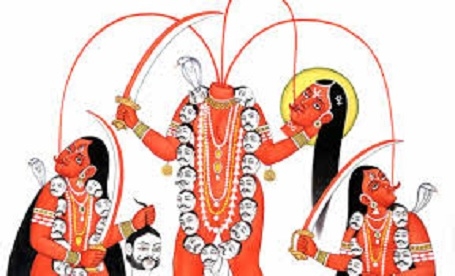Chhinnamasta - The consciousness beyond the mind
| Date :31-Mar-2020 |

By Rajendra Diwe :
Maa Chhinnamasta is the sixth among Dasha Mahavidya. The image of Chhinnamasta is a severed head. She is the Goddess who causes us to cut off our own heads or to dissolve our minds into pure awareness. She brings transcendence of the mind and represents the non-mind (unmana) state. Freed from the limitations of the mind, consciousness realises its true nature beyond death and sorrow. Chhinnamasta -- A severed head -- is perhaps the most frightening or disturbing form of the Goddess. She has cut off her own head and, holding it in her right hand; and drinks the blood flowing from her own severed neck. Yet her face is not frightening but happy, even blissful.
What she presents is the joy of transcending the body, not the pain of losing it. She is the most energetic form of Goddess and shows power of transformation in action. ‘The special significance of the Phalaharini Kali Puja in the Ramakrishna Sangha’ is the book penned by Swami Hiranmayanandaji in 1929. In this book he mentions, “The Phalaharini-Kali-Puja is performed in many centres of the Ramakrishna Math and Mission. This Kali Puja has a special bearing on the Ramakrishna Sangha. On this day Bhagavan Sri Ramakrishna observed the end of his sadhaka-life.
He worshipped Sri Saradamani Devi as Goddess Shodasi on this day. Adyashakti has various names and forms. Of those, Kali, Tara, Shodasi, Bhuvaneswari, Chhinnamasta, Bhairavi, Dhumavati, Bagala, Matangi and Kamala are well-known. Sri Ramakrishna worshipped Adyashakti, the Goddess of the universe through manifestation of the ‘Vidya-rupini’, a female human form embodying transcendent knowledge, and surrendered himself, his rosary and all other aids to his sadhana at Her feet and drew an end to his sadhana.
The book elaborates, “As the power of India, Chhinnamasta is vidyut or lightening, the electrical energy of transformation (Vidyut Shakti) working in the cosmos on all levels. The electricity functions as power of instantaneous enlightenment. While Kali rules over this force generally, Chhinnamasta represents the weapon of the Supreme. She is the lightening bolt of insight which destroys ignorance and lifts us beyond the skies. As lightening, She represents direct perception, pure seeing.
She is the power of self-vision which sacrifices all objects, including our own bodies, to reality of pure awareness. She represents the Atmayajna or Self-sacrifice, wherein we offer ourselves to Divine through sacrifice of mind.” Swamiji explains, “Chhinnamasta represents the pralaya or end of the world wherein the Absolute reabsorbs or swallows up all creation. She is the head that swallows up the entire body. Hence she is the power of destruction. According to yogic science there are knots (granthis) which prevent the movement of energy from flowing up the Sushumna of the subtle body. These are the Brahma-granthi in the Root Chakra which represents our bondage to speech, the Vishnu-granthi in the Heart Chakra showing our bondage to emotion, and the Rudra-granthi in third eye showing our bondage to thought. She represents piercing of Rudra-granthi, allowing us to transcend thought mind and body consciousness altogether.”
“Chhinnamasta thus represents the free flow of energy through the Sushumna. She is the Kundalini Shakti flowing upward from the base of the spine to burst open the Crown Chakra and stream out into the infinite. She shows the energy of Kundalini awake and moving upwards toward transformation. She is Kundalini in her active and assertive role. As such, she represents the Vedic Path of the Gods (Devayana), which is the movement of the Prana up the Sushumna to the formless realms of pure consciousness, symbolized by the sun,” Swamiji states. Scripture says, “Chhinnamasta has a naked headless body, and in her two hands holds her own severed head and a sword. With her severed head, via a long and stretched out tongue, she ecstatically drinks the central stream of blood which flows from her headless trunk. The severed head is located in her right hand, often portrayed as placed inside a skull cup.
The sword or head-chopper is located in the left. Her body is that of a girl of sixteen years of age and is adorned with a garland of severed heads and necklaces of bones. She wears a serpent as the sacred thread on her upper torso, and she has large breasts which are covered by lotus flowers.” Her hair is spread out in strands like lightning and adorned with various flowers, with a single gem tied by a serpent as a cord at the top. Here three eyes are wide open and emanating light. She has two companions called Dakini and Varnini to her left and right. She dances on bodies of Kama, the God of love, and his consort Rati, who are in a sexual embrace. In some portrayals it is Radha and Krishna upon whom she dances.